Experimental Detection of Particle Structures Detachment from a Stretchable Single Fiber during Multiple Consecutive Stretching Cycles
Abstract
:1. Introduction
2. Materials and Methods
2.1. Fibre and Particulate Material
2.2. Aerosol Generation and Loading Procedure
2.3. Multiple Stretching Cycle
2.4. Large Structure Detection System
2.5. Determination of Cumulative Fraction of Detached Particle Structure from Total Structure and Residual Structure on Fiber
3. Results and Discussion
3.1. Variation of Particle Loading Time
3.2. Influence of Elongation Velocity
3.3. Development of Structure Size
4. Conclusions and Outlook
- The application of multiple excitation cycle induces shear stress multiple times to the particle structure therefore enables complete detachment of the huge and compact particle structure from the stretchable filter fiber at low gas flow velocities of 0.05 m s.
- High initial particle loading (15 min) on the fiber induces detachment of larger particle structures from the fiber than for small initial particle loading (5 min) due to development of larger crack distances l during the stretching procedure and more particulate material on the fiber. The detected particle structures will be able to pass gaps between fibers in a total fibrous filter.
- For high initial particle loading on the fiber, the detachment of structures starts at lower fiber elongation than for small particle structures on the fiber, regardless the superficial velocity. This fact suggests with a higher loading within the total filter, less stretching distance is required for the same detachment success.
- For small initial structures on the fiber, an increase in elongation velocity causes earlier detachment of particle fragments during the first and the 2nd–5th stretching cycle due to faster development of cracks within the particulate structure.
- Detachment of particle structures occurs more likely after failure of cohesion—A small residual layer of particles remains on the fiber after the first stretching cycle due to adhesion.
- The number of required stretching cycles for “complete detachment” is reduced by the increase of the elongation velocity.
- The combination of low elongation velocity and low superficial velocity favours detachment of small particle structures from the fiber that can move into downstream layers of a potential filter.
- For the experiments with an elongation velocity of 0.6 mm s and a small initial structure on the fiber, detachment only is detected in the 2nd–5th cycle, regardless of the superficial velocity.
- Regardless the superficial velocity during the fiber stretching procedure, the size of is increased by an increase of elongation velocity.
- With an external excitation, detachment of glass particle structures smaller than 100 m are observed at flow velocities of 0.05 m s.
- Detachment of particle structures (piles of particles) is initiated at a superficial velocity below 1.2 m s due to the multiple external excitation (fiber stretching) which causes emerging cracks and the break up of the initial structure on the fiber.
- Detachment of particle fragments is increased due to external excitation within the range of operation filtration velocity. The size of detached structures presumes that detachment within a filter is possible, but probably no penetration through the entire filter will occur.
Author Contributions
Funding
Institutional Review Board Statement
Informed Consent Statement
Data Availability Statement
Acknowledgments
Conflicts of Interest
Abbreviations
| DFG | Deutsche Forschungsgemeinschaft |
| LSDS | Large Structure Detection System |
| pro. a. | Projection Area |
| PM | Photomultiplier |
| MFC | Mass Flow Controller |
References
- Song, C.B.; Park, H.S.; Lee, K.W. Experimental study of filter clogging with monodisperse PSL particles. Powder Technol. 2006, 163, 152–159. [Google Scholar] [CrossRef]
- Payet, S.; Boulaud, D.; Madelaine, G.; Renoux, A. Penetration and pressure drop of HEPA Filter during loading with submicron liquid particle. J. Aerosol Sci. 1992, 23, 723–735. [Google Scholar] [CrossRef]
- Bourrous, S.; Bouilloux, L.; Ouf, F.X.; Appert-Collin, J.C.; Thomas, D.; Tampère, L.; Morele, Y. Measurement of the Nanoparticles Distribution in Flat and Pleated Filters During Clogging. Aerosol Sci. Technol. 2014, 48, 392–400. [Google Scholar] [CrossRef] [Green Version]
- Bourrous, S.; Bouilloux, L.; Ouf, F.X.; Lemaitre, P.; Nerisson, P.; Thomas, D.; Appert-Collin, J.C. Measurement and modeling of pressure drop of HEPA filters clogged with ultrafine particles. Powder Technol. 2016, 289, 109–117. [Google Scholar] [CrossRef]
- Thomas, D.; Penicot, P.; Contal, P.; Leclerc, D.; Vendel, J. Clogging of fibrous filters by solid aerosol particles Experimental and modelling study. Chem. Eng. Sci. 2001, 56, 3549–3561. [Google Scholar] [CrossRef]
- Brown, R.C. Air Filtration: An Integrated Approach to the Theory and Applications of Fibrous Filters; Pergamon Press Ltd.: Oxford, UK, 1993. [Google Scholar]
- Verein Deutscher Ingenieure. VDI 3677; Filternde Abscheider Tiefenfilter aus Faser; Verein Deutscher Ingenieure: Dusseldorf, Germany, 2004. [Google Scholar]
- Jackiewicz, A.; Jakubiak, S.; Gradoń, L. Analysis of the behavior of deposits in fibrous filters during non-steady state filtration using X-ray computed tomography. Sep. Purif. Technol. 2015, 156, 12–21. [Google Scholar] [CrossRef]
- Tippayawong, N.; Preechawuttipong, I. (Eds.) Modified kinetic model of particle detachment by aerodynamic drag and vibration. In Proceedings of the World Congress on Engineering and Computer Science, London, UK, 30 June–2 July 2010; Volume II. [Google Scholar]
- Poggemann, L.; Meyer, J.; Dittler, A. A novel method to investigate detachment of particulate structures from an elastic single fiber at low gas flow velocities. J. Aerosol Sci. 2021, 156, 105785. [Google Scholar] [CrossRef]
- Jankowska, E.; Reponen, T.; Willeke, K.; Sergey, A.G.; Choi, K.J. Collection of fungal spores on air filters and spore reentrainment from filters into air. J. Aerosol Sci. 2000, 31, 969–978. [Google Scholar] [CrossRef]
- Larsen, R.I. The Adhesion and Removal of Particles Attached to Air Filter Surfaces. Am. Ind. Hyg. Assoc. J. 1958, 19, 265–270. [Google Scholar] [CrossRef]
- Löffler, F. Abblasen von an Filterfasern abgeschiedenen Feststoffteilchen. Verfahrenstechnik 1972, 6, 3–7. [Google Scholar]
- Przekop, R.e.a. Lattice-Boltzmann approach for description of the structure of deposited particulate matter in fibrous filters. J. Aerosol Sci. 2003, 34, 133–147. [Google Scholar] [CrossRef]
- Qian, Y.; Willeke, K.; Ulevicius, V.; Grinshpun, S.A. Particle Reentrainment from Fibrous Filters. Aerosol Sci. Technol. 1997, 27, 394–404. [Google Scholar] [CrossRef]
- Zoller, J.; Zargaran, A.; Braschke, K.; Meyer, J.; Janoske, U.; Dittler, A. Experimental Investigation of Reactive-Inert Particulate Matter Detachment from Metal Fibres at Low Flow Velocities and Different Gas Temperatures. Aerosol Sci. Eng. 2020. [Google Scholar] [CrossRef]
- Beuth, J.L. Cracking of thin bonded films in residual tension. Int. J. Solids Struct. 1992, 29, 1657–1675. [Google Scholar] [CrossRef]
- Thouless, M.D. Crack Spacing in Brittle Films on Elastic Substrates. J. Am. Ceram. Soc. 1990, 73, 2144–2146. [Google Scholar] [CrossRef]
- Leung, W.W.F.; Choy, H.F. Transition from depth-to-surface filtration for a high-efficiency, high-skin effect, nanofiber filter under continuous nano-aerosol loading. Chem. Eng. Sci. 2018, 182, 67–76. [Google Scholar] [CrossRef]
- Wurster, S.; Kampa, D.; Meyer, J.; Müller, T.; Mullins, B.J.; Kasper, G. Measurement of oil entrainment rates and drop size spectra from coalescence filter media. Chem. Eng. Sci. 2015, 132, 72–80. [Google Scholar] [CrossRef]
- Wurster, S. Entrainment von Öltropfen an der Rückwand eines Faserfilters. Ph.D. Thesis, Karlsruhe University, Karlsruhe, Germany, 2017. [Google Scholar]
- Japuntich, D.A.; Stenhouse, J.I.T.; Liu, B.Y.H. Experimental Results of solid monodisperse particle clogging of fibrous filters. J. Aerosol Sci. 1994, 25, 385–393. [Google Scholar] [CrossRef]
- Bahners, T.; Schollmeyer, E. Computer simulation of the filtration process in a fibrous filter collecting polydisperse dust. J. Aerosol Sci. 1986, 17, 191–200. [Google Scholar] [CrossRef]
- Schweers, E.; Umhauer, H.; Löffler, F. Experimental Investigation of Particle Collection on Single Fibres of Different Configurations. Part. Part. Syst. Charact. 1994, 11, 275–283. [Google Scholar] [CrossRef]
- Hoppe, K.; Maricanov, M.; Schaldach, G.; Zielke, R.; Renschen, D.; Tillmann, W.; Thommes, M.; Pieloth, D. Modeling the separation performance of depth filter considering tomographic data. Environ. Prog. Sustain. Energy 2020, 39. [Google Scholar] [CrossRef] [Green Version]
- Müller, T. Trägheitsabscheidung von Partikeln an parallelen Faserarrays; Verfahrenstechnik, Dr. Hut: München, Germany, 2017. [Google Scholar]
- Kanaoka, C.; Hiragi, S. Pressure Drop Of Air Filter With Dust Load. J. Aerosol Sci. 1990, 21, 127–137. [Google Scholar] [CrossRef]
- Kanaoka, C.; Emi, H.; Myojo, T. Simulation of the growing process a particle dendrite and evaluation of a single fiber collection efficiency with dust load. J. Aerosol Sci. 1979, 1980, 377–389. [Google Scholar] [CrossRef]
- Kuwabara, S. The Forces experienced by Randomly Distributed Parallel Circular Cylinders or Spheres in a Viscous Flow at Small Reynolds Numbers. J. Phys. Soc. Jpn. 1959, 14, 527–532. [Google Scholar] [CrossRef]
- Zoller, J.; Zargaran, A.; Braschke, K.; Meyer, J.; Janoske, U.; Dittler, A. Morphology of particulate deposits formed on a single filter fibre by exposure to mixed aerosol flow. J. Aerosol Sci. 2020, 152, 105718. [Google Scholar] [CrossRef]
- Kanaoka, C.; Emi, H.; Hiragi, S.; Myojo, T. Morphology of particulate agglomerates on a cylindrical fiber and a collection efficiency of a dust loaded fiber. Aerosols: Form. React. 1986, 2, 674–677. [Google Scholar]
- Kasper, G.; Schollmeier, S.; Meyer, J. Structure and density of deposits formed on filter fibers by inertial particle deposition and bounce. J. Aerosol Sci. 2010, 41, 1167–1182. [Google Scholar] [CrossRef]
- Broßmann, R. Die Lichtstreuung an kleinen Teilchen als Grundlage einer Teilchengrößenbestimmung. Ph.D. Thesis, Technische Hochschule, Karlsruhe, Germany, 1966. [Google Scholar]
- Leschonski, K. Partikelmeßtechnik. Berichte der Bunsengesellschaft für physikalische Chemie 1984, 88, 1112–1123. [Google Scholar] [CrossRef]
- Hamamatsu Photonics K.K. Electron Tube Division. In Photomultiplier Tubes: Basics and Application; Hamamatsu Photonics K.K. Electron Tube Division: Hamamatsu, Japan, 2007. [Google Scholar]
- Zoller, J.; Zargaran, A.; Braschke, K.; Meyer, J.; Janoske, U.; Dittler, A. A Novel Apparatus for Simultaneous Laser-Light-Sheet Optical Particle Counting and Video Recording in the Same Measurement Chamber at High Temperature. Sensors 2022, 22, 1363. [Google Scholar] [CrossRef]
- Otsu, N. A Threshold Selection Method from Gray-Level Histograms. IEEE Trans. Syst. Man, Cybern. 1979, 9, 62–66. [Google Scholar] [CrossRef] [Green Version]
- Nahta, R.; Moran, B. Crack Spacing in Brittle Films on Dissimilar Planar and Axisymmetric Elastic Substrates. Eng. Fract. Mech. 1995, 52, 513–524. [Google Scholar] [CrossRef]
- Nahta, R.; Moran, B. Film cracking and debonding in a coated fiber. Int. J. Fract. 1996, 79, 351–372. [Google Scholar] [CrossRef]

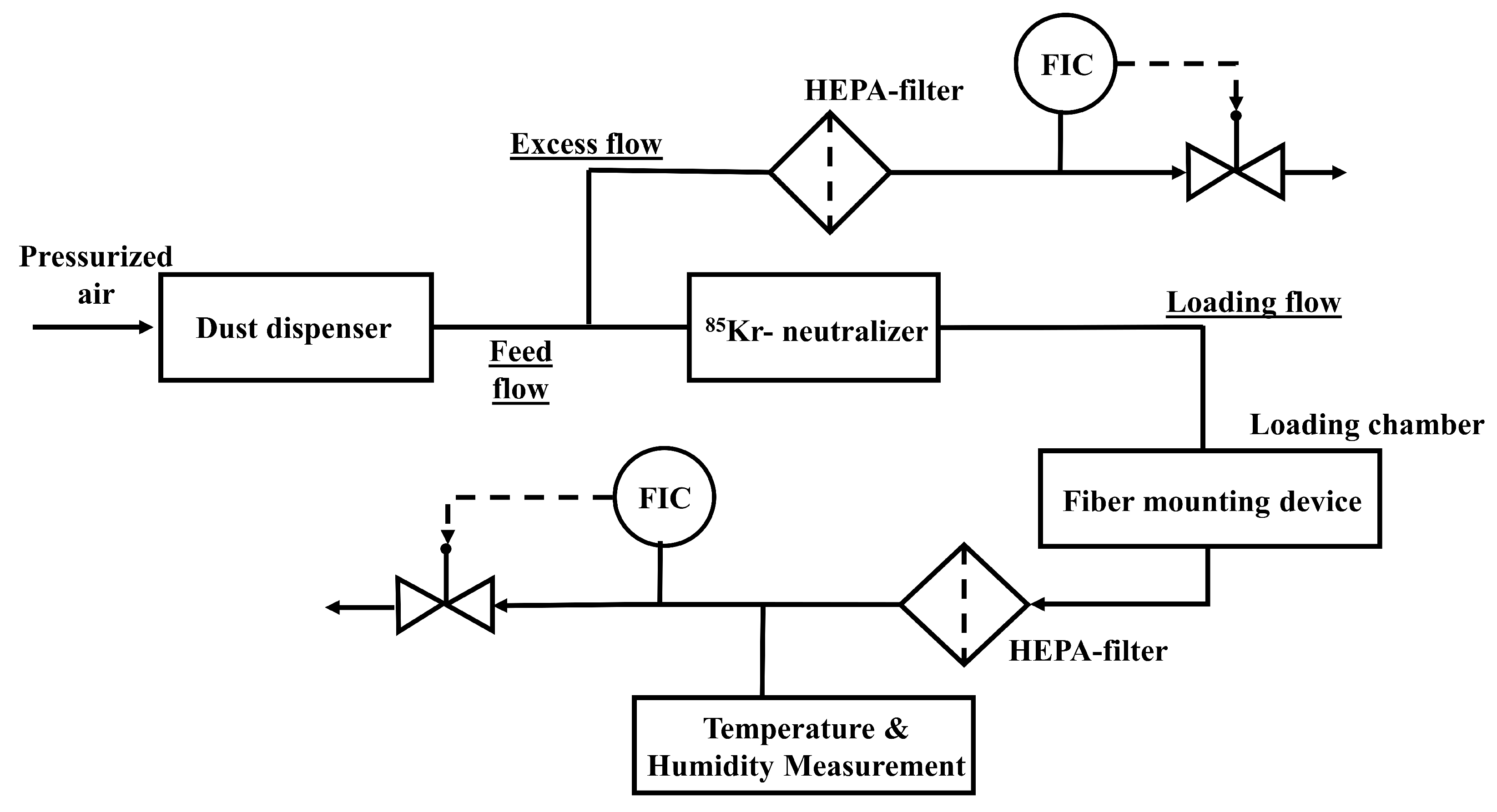
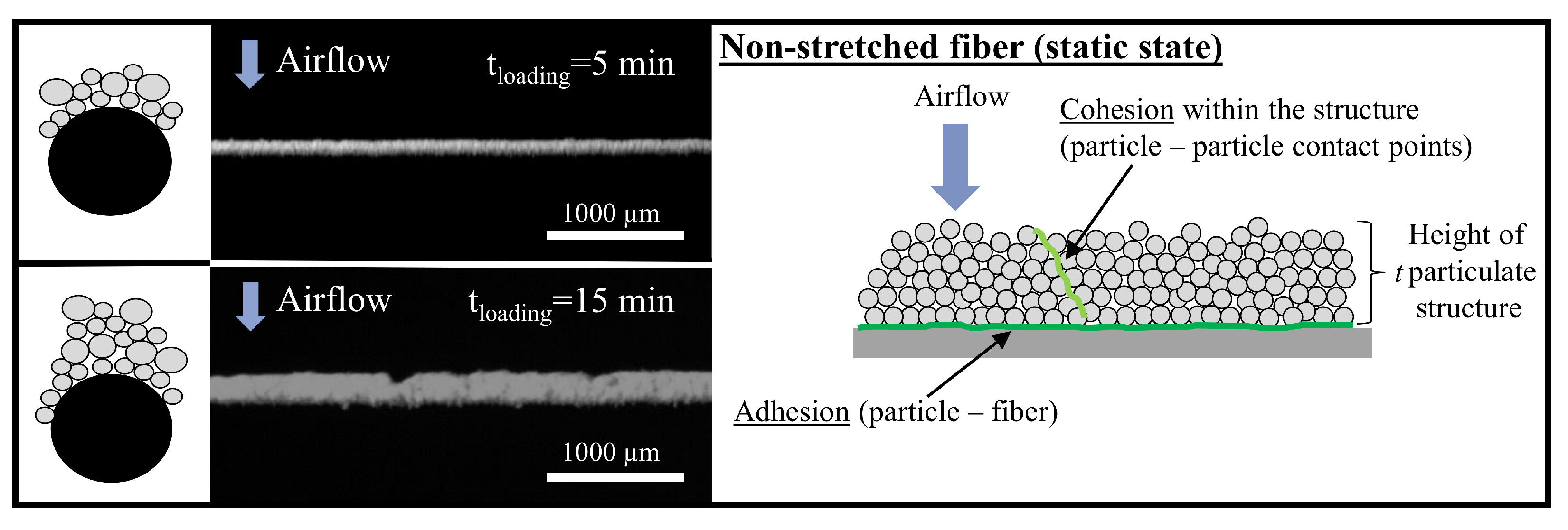
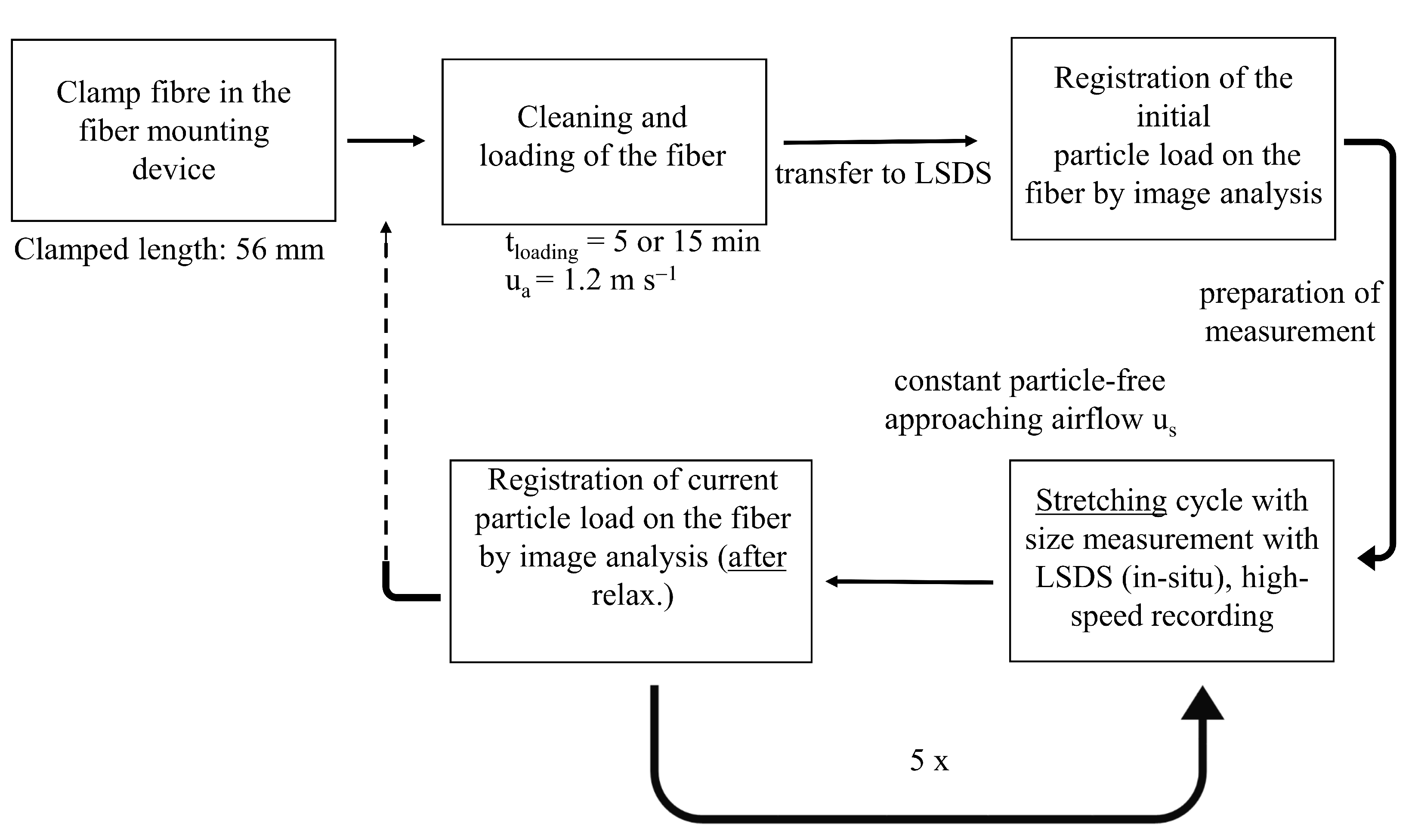
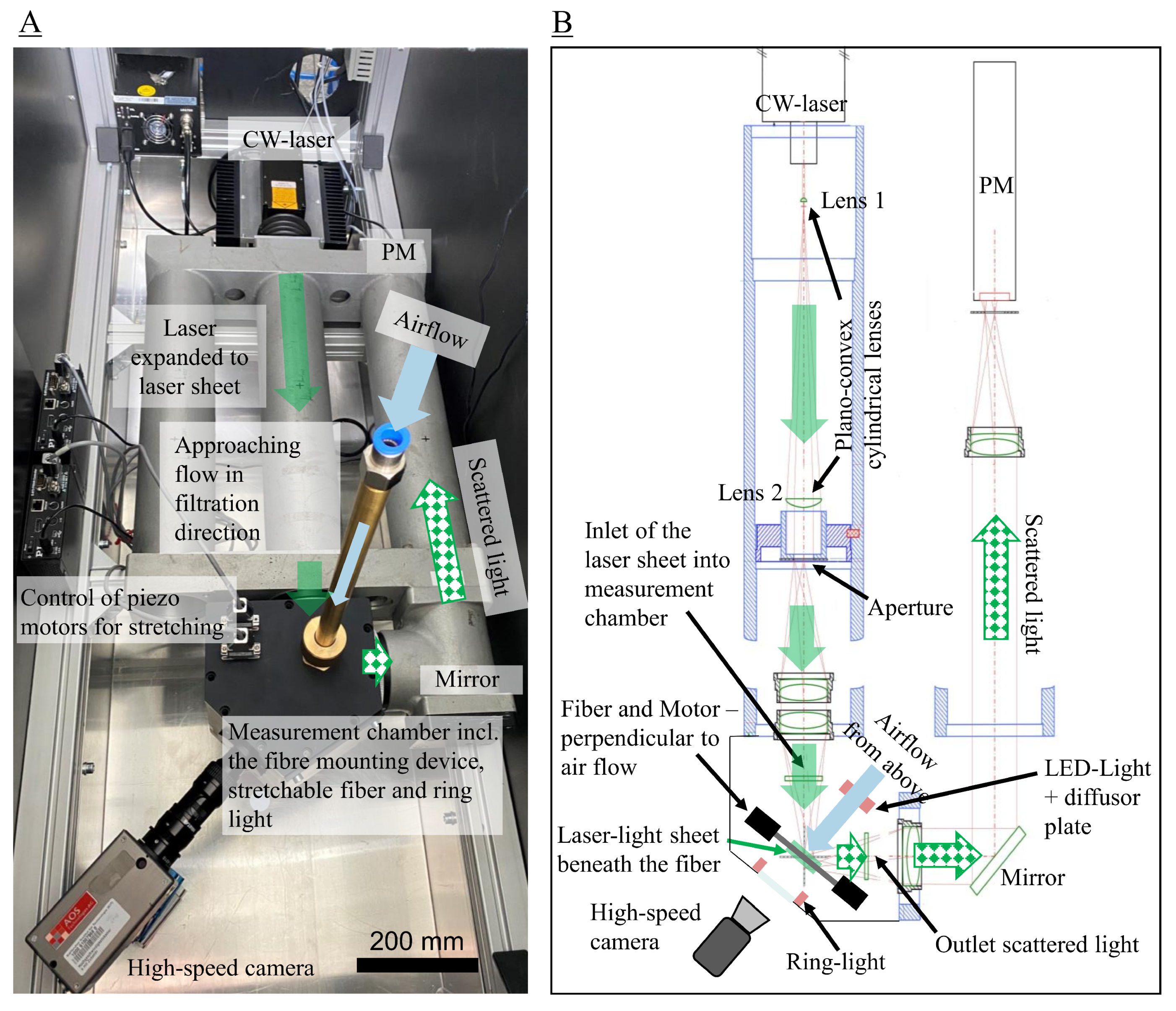
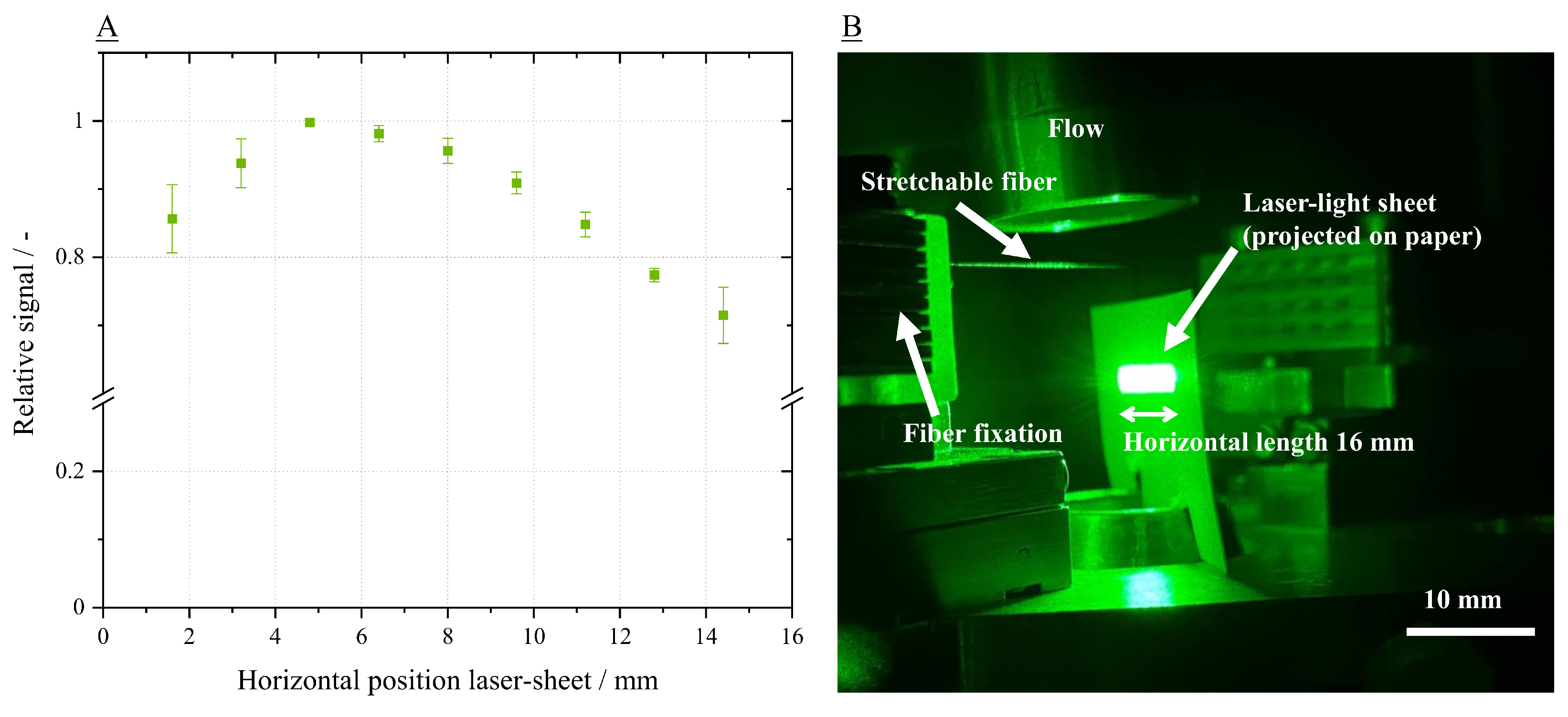
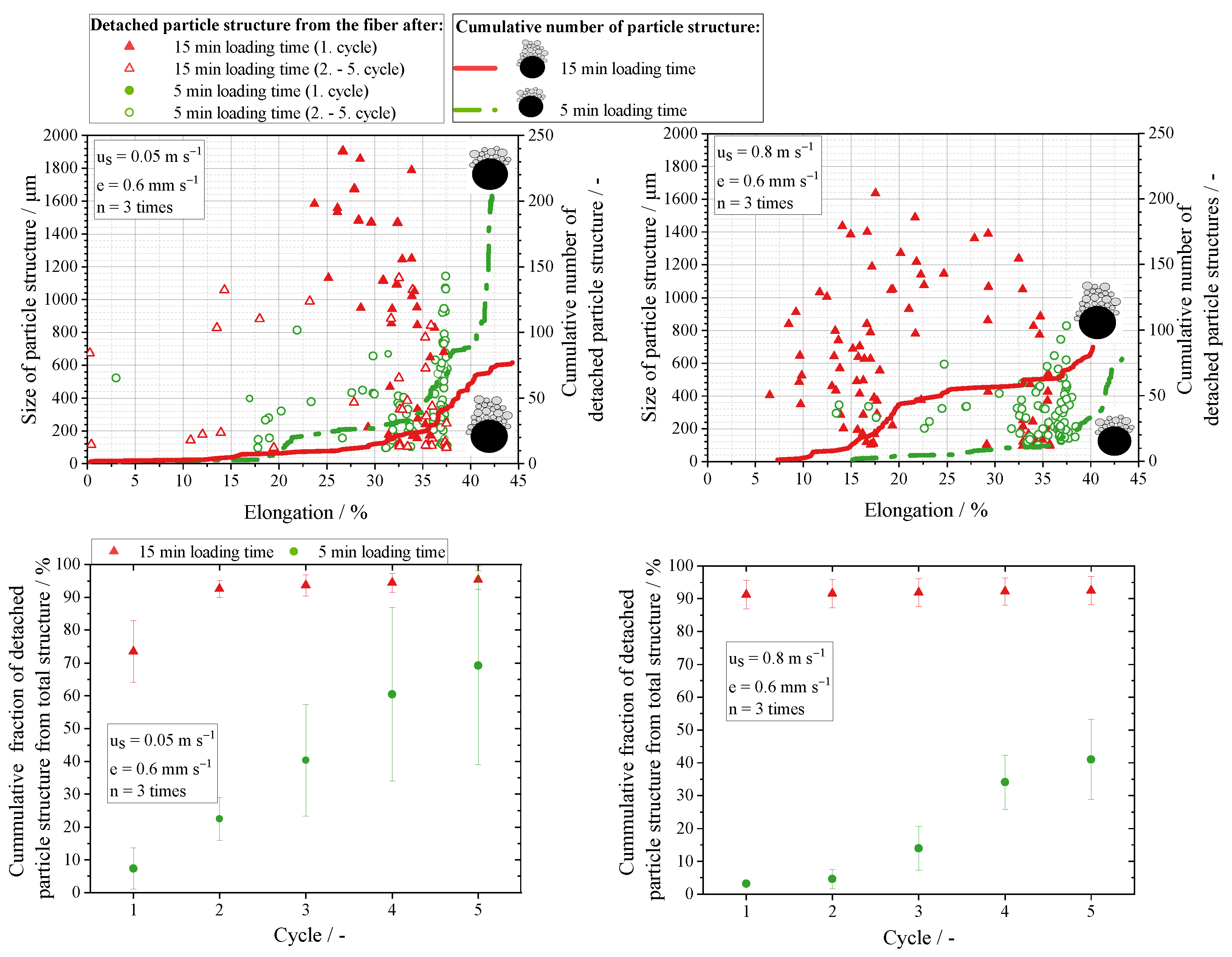
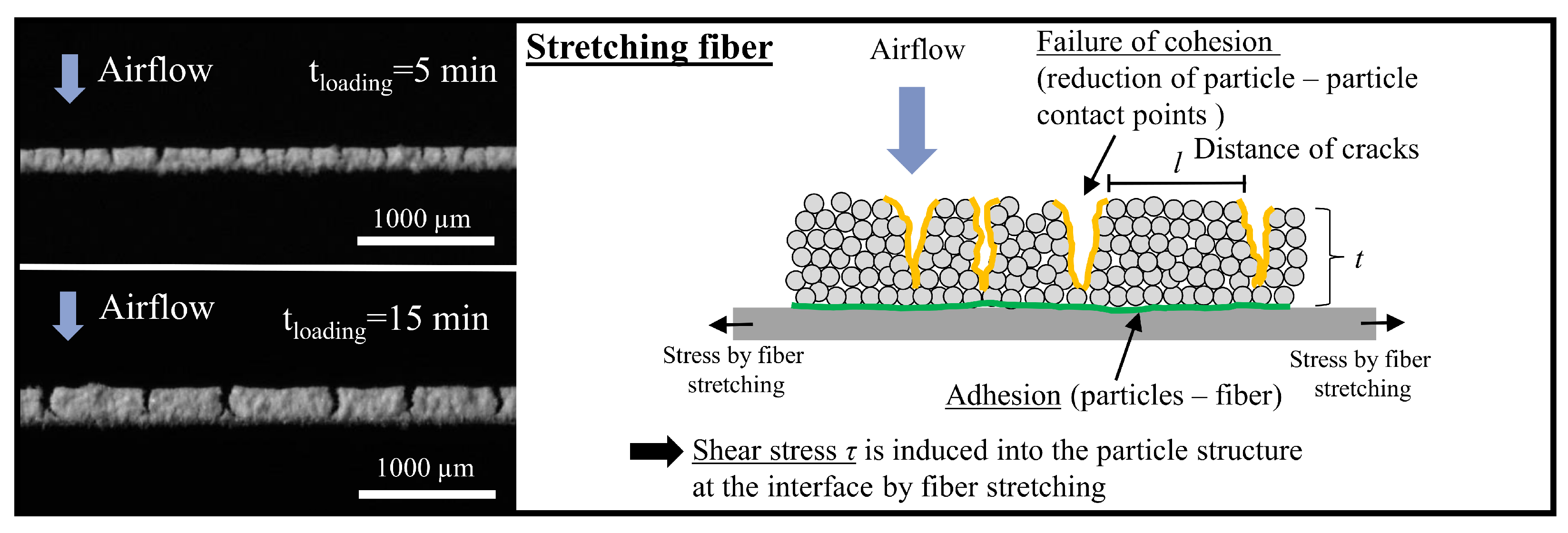
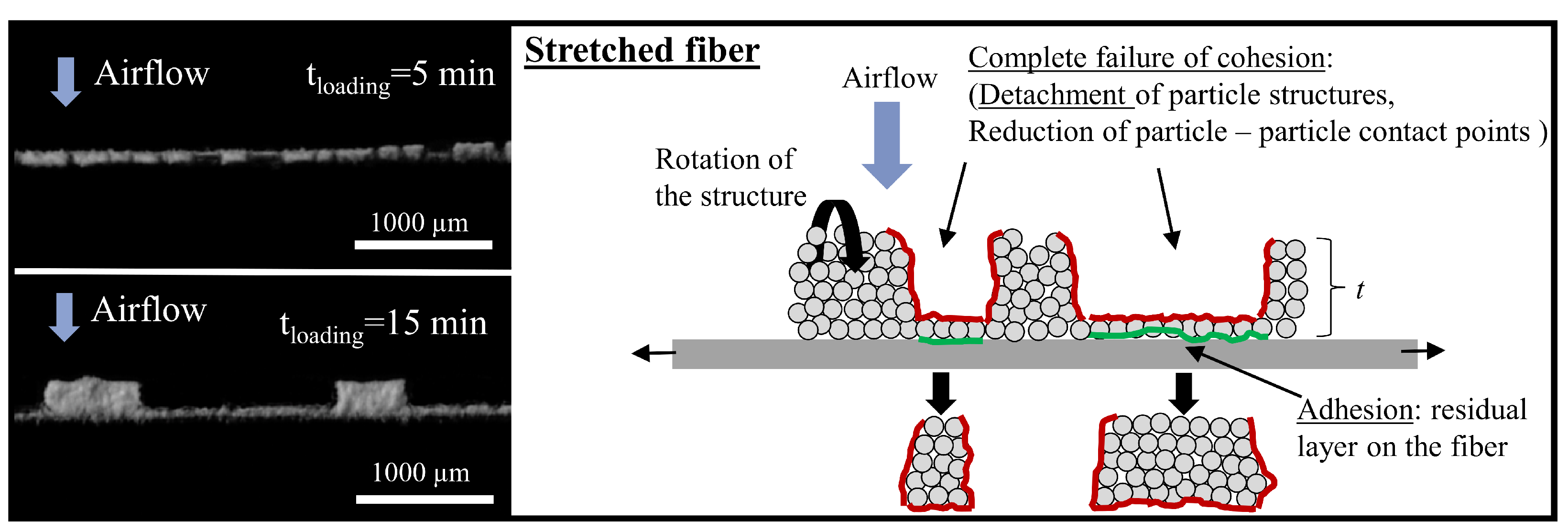
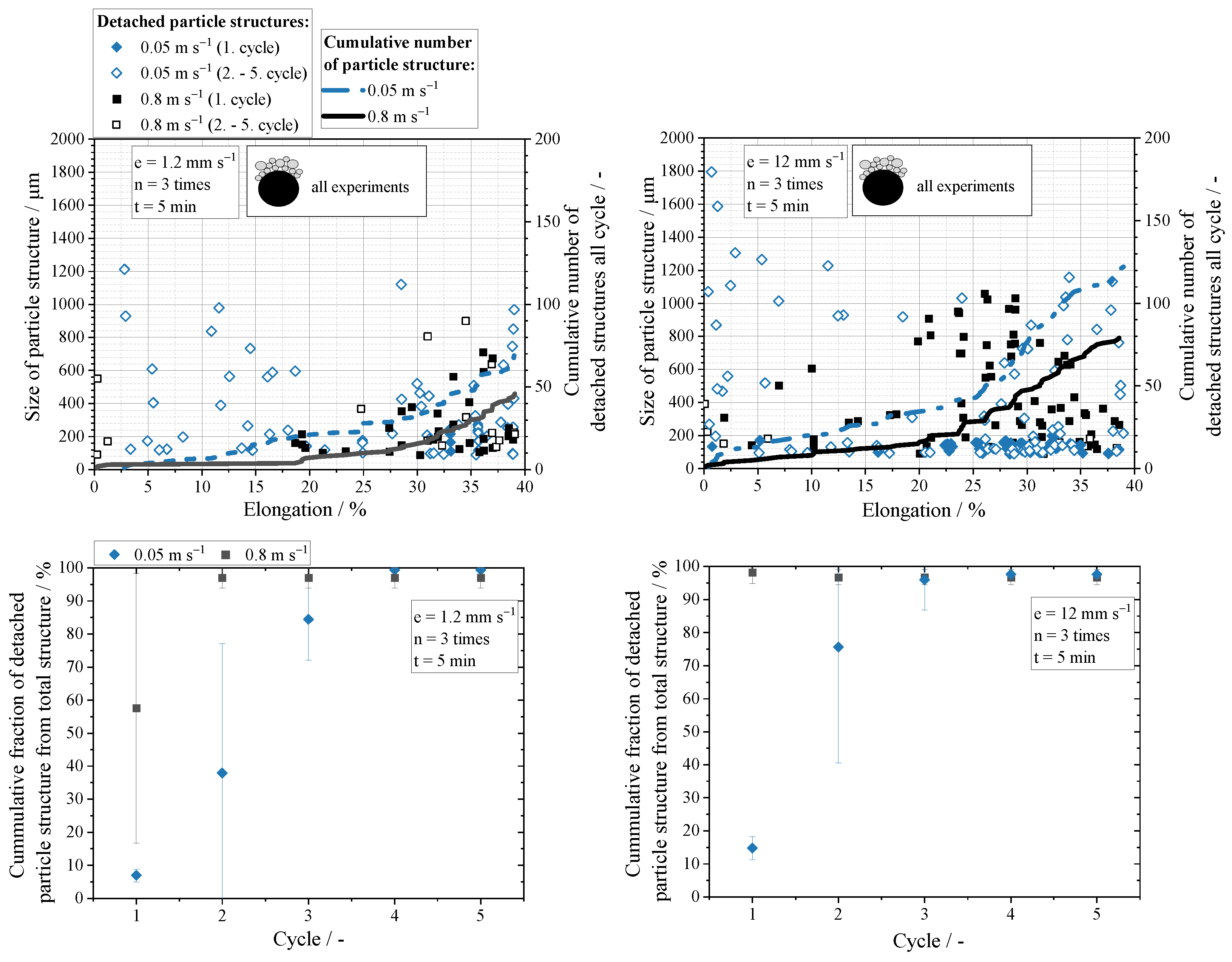
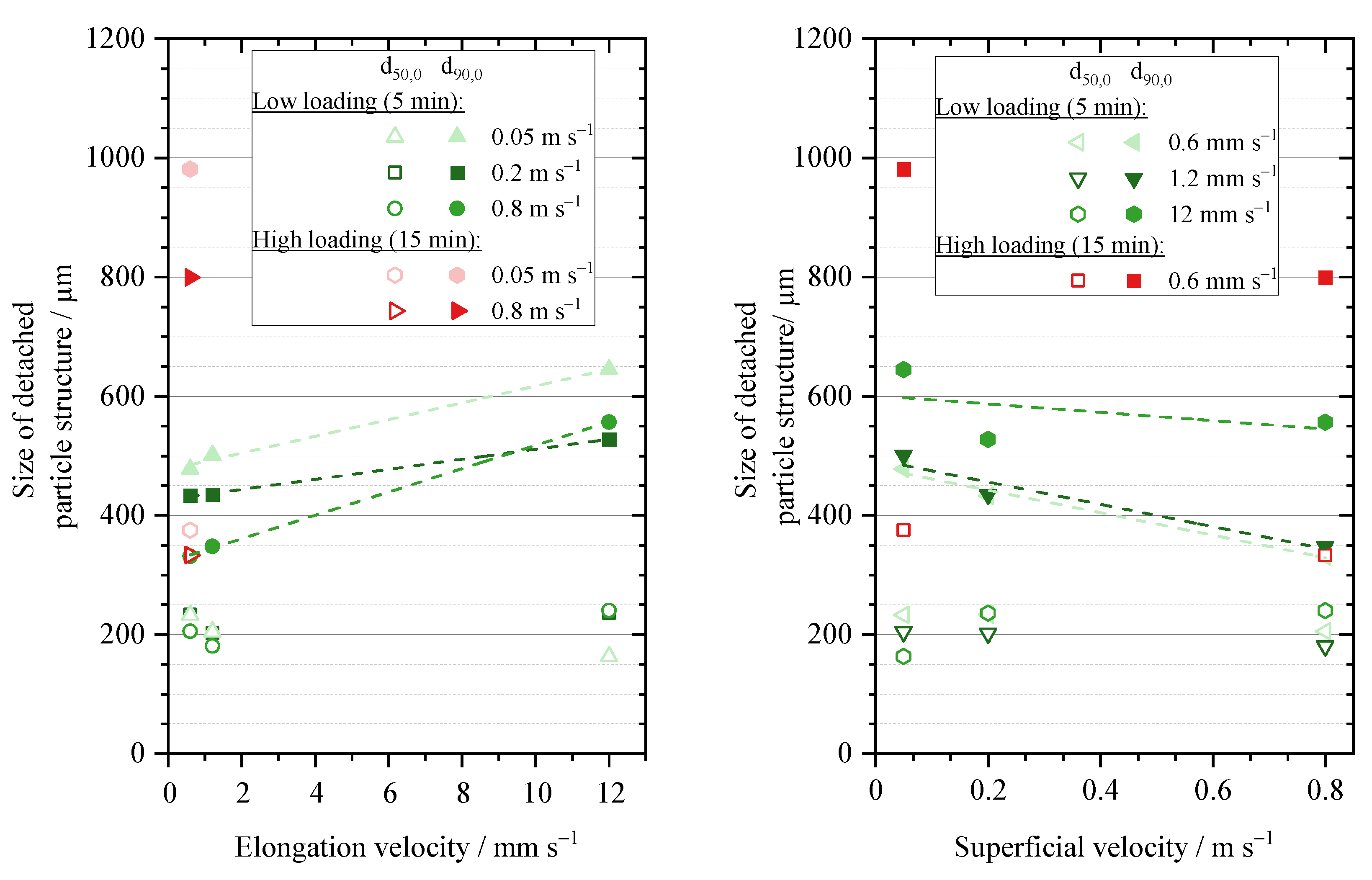
| Fibre Loading Time/min | Average Flow Velocity during Loading Procedure/m s | Superficial Velocity () during the Stretching/Relaxation Process/m s | Elongation Velocity (e)/mm s |
|---|---|---|---|
| 5; 15 | 1.2 | 0.05; 0.2; 0.8 | 0.6; 1.2; 2.0; 12.0 |
Publisher’s Note: MDPI stays neutral with regard to jurisdictional claims in published maps and institutional affiliations. |
© 2022 by the authors. Licensee MDPI, Basel, Switzerland. This article is an open access article distributed under the terms and conditions of the Creative Commons Attribution (CC BY) license (https://creativecommons.org/licenses/by/4.0/).
Share and Cite
Poggemann, L.; Meyer, J.; Dittler, A. Experimental Detection of Particle Structures Detachment from a Stretchable Single Fiber during Multiple Consecutive Stretching Cycles. Separations 2022, 9, 168. https://doi.org/10.3390/separations9070168
Poggemann L, Meyer J, Dittler A. Experimental Detection of Particle Structures Detachment from a Stretchable Single Fiber during Multiple Consecutive Stretching Cycles. Separations. 2022; 9(7):168. https://doi.org/10.3390/separations9070168
Chicago/Turabian StylePoggemann, Lukas, Jörg Meyer, and Achim Dittler. 2022. "Experimental Detection of Particle Structures Detachment from a Stretchable Single Fiber during Multiple Consecutive Stretching Cycles" Separations 9, no. 7: 168. https://doi.org/10.3390/separations9070168
APA StylePoggemann, L., Meyer, J., & Dittler, A. (2022). Experimental Detection of Particle Structures Detachment from a Stretchable Single Fiber during Multiple Consecutive Stretching Cycles. Separations, 9(7), 168. https://doi.org/10.3390/separations9070168






